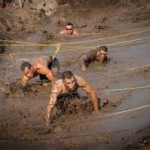 Should you consider an Obstacle Course Race?
Should you consider an Obstacle Course Race?
Pick up just about any race calendar or fitness magazine and you’re sure to read about the latest craze of obstacle course racing. And for good reason, they are challenging, inspiring, and so much fun!
Here’s why you should consider adding an obstacle course race to your fitness schedule:
Total body workout. The multi-dimensional format for races consists of running from obstacle to obstacle. Shorter course races of three to five miles usually include 10+ obstacles which challenge upper body strength, lower body strength, muscle endurance, balance, flexibility and agility. Your approach heading into a race should be, be prepared for anything!
Prep requires cross-training. Instead of focusing on only one activity like training for a marathon, obstacle courses force training in many disciples and athletics. Crossing ladders, swinging across rings, climbing walls, pulling ropes, carrying sandbags all require unique training. Limited only by your imagination.
Super charged motivation. You’ll be racing with 500+ of your new best friends…or new rivals! Many mid-pack racers find they are encouraged by fellow competitors and push harder than they would (or thought they could) otherwise. For many races, the tone is supportive and motivating. Many racers are competing for the first time and accomplishing tasks they never dreamed possible.
Builds life confidence. Whether racing for the podium or for the finish line. During a race you will undoubtedly be faced with a task you never thought you could accomplish. You’ll have to control your mental focus, negotiate your approach, practice positive self-talk, push through physical discomfort, battle fatigue…and you WILL! Through mastering this discipline, you’ll build confidence in your ability to conquer fears, master anxiety and uncertainty. The feeling you’re left with, empowerment! This empowerment will transfer into all areas of your life because you’ll know you’re able to accomplish whatever you set your mind to accomplish.
The element of PLAY! Running, jumping, hopping, crawling, swinging, balancing, throwing are all included in the obstacles you’ll encounter. You’ll feel like a kid again on the playground at school! Not all exercise has to be structured to count toward fitness. Not all reps have to be counted and quantified. You’ll have one approach, GO!
 Subscribe
Subscribe




